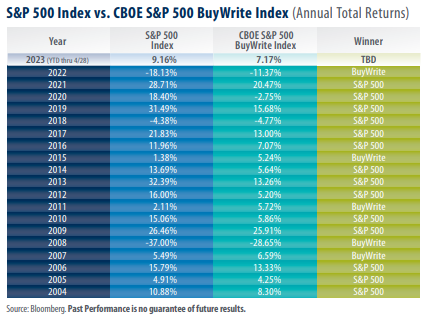
View from the Observation Deck
Covered call strategies tend to be most beneficial when the stock market posts negative
returns, or when returns range from 0%-10%.
The S&P 500 Index posted negative total returns just three times in the table above. The CBOE BuyWrite Index outperformed the S&P 500 Index in two of those three years (missing the hat trick 3/3 by 0.39 percentage points in 2018). For comparison, there are four years in the table where the S&P 500 Index posted returns between 0% and 10%. During those time periods, the CBOE BuyWrite Index outperformed the S&P 500 Index in three of the four years (missing the fourth year by 0.66 percentage points in 2005). Year-to-date through 4/28, the S&P 500 Index has outperformed the CBOE BuyWrite Index by 1.99 percentage points.
Covered call options can generate an attractive income stream, but they can also cap the potential for capital appreciation.
There were 12 years in the table where the S&P 500 Index posted total returns of 10% or more. The CBOE BuyWrite Index underperformed the S&P 500 in every one of them.
Takeaway
Covered call strategies offer a unique alternative to the S&P 500 Index. The income they provide has generally led to outperformance during negative or moderately positive periods. This income comes at a potential cost, however, as returns can be capped during periods where the market is performing exceedingly well. As the table shows, the CBOE BuyWrite Index outperformed the S&P 500 Index in five of the seven periods where the S&P 500 Index posted annualized total returns of 10% or less. For comparison, the CBOE BuyWrite Index underperformed the S&P 500 Index in all 12 of the years where the S&P 500 Index posted returns of more than 10%.



